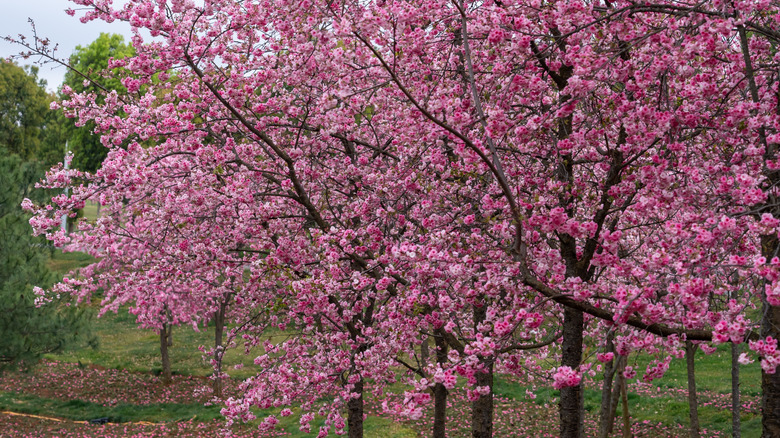Entice Cardinals & Hummingbirds To Your Yard With A Flowering Tree They Can't Resist
If you're looking for flowering trees to attract hummingbirds and cardinals to your yard, few do it as beautifully as the Kwanzan cherry (Prunus serrulata). Beloved for its lush, double-pink blossoms that bloom in early to mid-spring, this gorgeous flowering tree is considered one of the most ornamental cultivars of the Japanese cherry. Its ruffled flowers often appear just before or alongside the foliage, forming a cloud-like, rounded canopy of bright pink blooms before the dark green, ovate leaves fully emerge. It offers multi-season interest, with foliage that fades to shades of yellow and orange-bronze in autumn.
Beyond its beauty, the Kwanzan cherry will turn your yard into a hotspot for wildlife. Songbirds like cardinals will appreciate its dense branching, while its nectar-rich blooms will draw in an array of pollinators, including hummingbirds and bees. This showy species makes the perfect specimen tree, whether you want to grow it directly in the ground or in a container. With a life span of about 15 to 25 years, its vibrant flowers and benefits for feathered friends will provide exceptional color and lively wildlife visits for years to come.
Why this tree attracts hummingbirds and cardinals
To transform your backyard into a bird-friendly haven, you'll need to provide easy access to everything they need. Birds are more likely to make repeat visits if food, water, shelter, and quality nesting sites are all in one general area. One common mistake to avoid if you're trying to attract cardinals is relying on birdhouses. Because they aren't cavity nesters, they look for shrubs and small trees to retreat to when building their nests or hiding from predators. The Kwanzan cherry tree's dense crown provides cardinals and other birds with prime real estate to raise their young along with sturdy branches for perching. Although this ornamental tree doesn't produce fruit, it does attract a variety of insects that cardinals will enjoy snacking on.
While female cardinals are busy gathering nest-building supplies, hummingbirds will be on the hunt for food. These tiny birds have high metabolisms and burn a lot of energy, so they need to make frequent feeding stops to survive, often visiting hundreds of flowers in a single day. Thanks to the Kwanzan cherry's abundance of nectar-rich blooms, these fast-moving birds will have no shortage of fuel. They also need protein for themselves and their young, so they'll pick off caterpillars and other bugs that are drawn to the tree. Hummingbirds have impressive memories and often return to familiar feeding areas, so there's a good chance they'll keep coming back to a yard overflowing with bright pink blossoms.
How to grow a Kwanzan cherry tree to entice hummingbirds and cardinals
Kwanzan cherry trees thrive in USDA hardiness zones 5 through 9 and prefer a sunny spot to put out their best blooms, though they can tolerate light shade. They grow best in moist, well-drained soil and aren't too picky about texture, whether it's a sandy or clay loam. Attract more birds to your garden by planting it in an area near other trees or shrubs, as cardinals are more likely to nest in woodland or lightly forested areas where they feel sheltered from predators. Similarly, hummingbirds like yards with plenty of shrubbery for cover and perching but also prefer to have an open section where they can hunt for insects or stop by other flowering plants.
Once you've planted your Kwanzan cherry tree, keep the soil consistently moist but not soggy. This species can also be prone to fungal diseases like powdery mildew and leaf spot, especially in wet conditions. To help prevent fungal issues, water at the base of the tree and avoid wetting the foliage. Adding a 3 to 4-inch layer of mulch can help retain moisture, but leave a few inches of space around the trunk to maintain good airflow. Unless your tree has a fungal disease, you'll rarely need to prune. If you do decide to remove a few branches, first check for hidden nests, especially during nesting season, which is typically March through September for cardinals.


